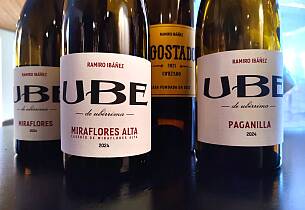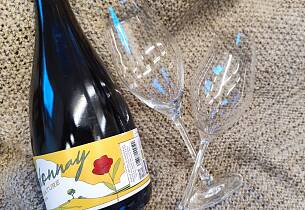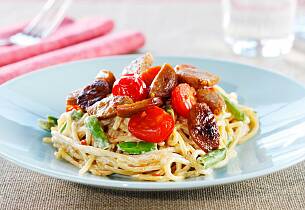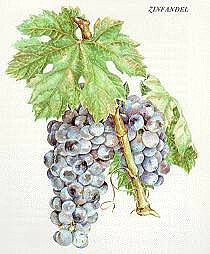 1) Jump to "Foreword/Database Links"
1) Jump to "Foreword/Database Links"2) Jump to "Introduction"
3) Jump to "Classic Vinifera Varieties and Synonyms"
4) Jump to "Lesser/Crossed European Vinifera Varieties"
5) Jump to "French-American/American Hybrid/Native Varieties"
6) Jump to "Introductory Information on Hybrids"
7) Jump to "Variety/Pest Image Links"
8) Jump to "General Notes on Grapevine Cultivation"
9) Jump to "Misc. Viticulture Links/FAQ/Glossary".
GLOSSARY FOREWORD/DATABASE LINKS
The following Wine-grape Glossary, containing a clickable INDEX listing andother clickable internal text links, is designed to aid individuals interested in knowing something about the fruit that is transformed into his or her favorite wine. It can be downloaded in either its ascii or hypertext format by the reader for free distribution among individuals. The only restriction is theright of authorship credit which should be retained on all copies made. Theglossary file, (approx. 445 Kb), will translate into about 220 pages of hardcopytext.
Because the potential scope is so huge only the more commonly grown or knownpopular grape-names are referenced. Written by a non-specialist for the benefit of non-specialists it is hoped that inaccurate taxonomy references will be overlooked, although a strong effort is made to limit the number of errors. Seekers of latin-style botanical names, hybrid-grape numberings, vine ampelographic descriptions etc. are advised to refer to an appropriate resource. Occasionally encountered alias lesser names are highlighted in accessed text but not "jumpably" link-referenced because they are not regarded as being important. Also, in order to allow conformity to current international standards and successful searches, an attempt has been made to use variety name spelling emulating that found in the Geilweilerhof database mentioned below (eg. the use of variety name suffixes such as "O.P" and "S.P" meaning "Open Pollinated" and "Self Pollinated" respectively) - although changes and modifications may be made from time to time as new facts emerge in the literature.
A recently (1996) published book, "Jancis Robinson's Guide to Wine Grapes",lists over 800 grapenames and to a degree renders this glossary obsolescent.However, because her book omits most American hybrid varieties and her listingconcentrates on european vinifera or crosses, readers may still find thefollowing file helpful and of some value.
Additionally a U.S. Dept. of Agriculture database search page can be accessedvia the link URL:
A Database page of interest to biologists concerned with genetic researchon grapevines is now available. The URL link is as follows:
New readers should be aware that their protocol system requires "frames"compatibility for best results with this technical resource.
Readers contemplating planting their own vines may find the Grape Diseasespage at UC Davis of interest. It is a comprehensive database that includesdisease example images. It can be browsed via the link URL:
NB: The Netscape/I.E menu bar "Edit" drop-down menu "Find in page" item offers rapid access to keywords throughout the glossary text (e.g; "Pierce's" for varieties resistant to Pierce's Disease).
Some comments on soil and vine preparation also appear near the end of thisglossary (see "General Note on Grapevine Cultivation" etc).
Cool climate dwellers should find the grape recommendations for New York Stateof interest. The Geneva Research Station of Cornell University lists theirevaluations at the link URL:
Readers interested in Rootstocks can find an informative article about them at the link URL:
Admirers of wine know that the type of grape from which wines are fermented willin large part determine the basic fruit-flavor characteristics, both aroma andtaste, of the final product. As a result, wines of high reputation are oftenregarded as associated with a single grape variety, often referred to as a"varietal", especially in the english-speaking world.
Because of this, such grape-names as Cabernet Sauvignon forred Bordeaux, Sémillon and Sauvignon Blanc for Sauternes, Pinot Noir forred Burgundy and Chardonnay for white Burgundy, (etc), arenow embedded in the "wine-speak" language. However these names can bemisleading because they imply a precision that in reality is not present.
An example is that there is no such thing as "the" Pinot Noir. In fact accuracydemands that it be referred to as "a" Pinot Noir because the name does notbelong to a unique vine species but to what the french grower calls a "cépage",that is, a growth defined as a group of closely related but not quite identicalvine species sharing the same genetic background. These different strains ofPinot Noir are technically known as "clones", usually individually identifiedby adding a secondary name that refers to a special characteristic, place nameor clone developer etc. It has been estimated that there are a minimum offorty-seven Pinot Noir clone versions currently, (1996), planted in thevineyards of Burgundy and nearby districts in France alone - resulting in agreat variation of wine quality and aging ability etc. The same sort ofsituation applies to many other strains of the "cépages nobles", or"noble varieties", such as the Rieslingand others.
Another example is the assumption, commonly made, that the highly regarded redBordeaux wines are made entirely from the Cabernet Sauvignon grape. In factmany of the famous "great crus" vineyards in Pomerol and St.Émilioncontain none at all. It is mainly grown in the Médoc and Gravessubdistricts and even there is only one of several vine varieties, recentfigures showing that fully 40% of the grapes grown consist of Merlot. Normallythe wine made from Cabernet Sauvignon is blended with wines made from suchdistantly related grapes as the Merlot,Cabernet Franc, Petit Verdot and others.
Knowing the above facts, the following information should be used with care.Many of the grape names will be found to be connected in some way and are crosscallable. When they are not it is usually for reasons of brevity, or lack of in-depth knowledge, because it would not serve any useful purpose to pursue thedetails about thousands of clones worldwide.
[A] Aubaine - Auvernat -Auvernat Noir
[B] Beaunois - Bigney -Black St. Peter - Blanc Doux -Blauburgunder -Blauer Klevner - Boal -Bordo - Bouchet -Bouchy - Breton
[C] Cabernet Franc -Cabernet Sauvignon - Carmenet -Chardonnay - Chenin Blanc -Chevrier - Chiavennasca -Columbier - Coraillod -Crabutet Noir
[E] Epinette Blanche
[F] Feinburgunder -[G] Gentil Rose Aromatique -Gewürztraminer -Green Grape -Gros Bouchet
[M] Malaga - Merlot -Morillon - Muscat -Muscat Blanc à Petit Grains -Muskat-Sylvaner
[O] Orange Muscat
[P] Petit Cabernet -Petite Sainte-Marie -Petite Vidure - Picutener -Pugnet - Pineau de la Loire -Pinot Blanco -Pinot Chardonnay -Pinot Nero - Pinot Noir -Plavac Mali - Primitivo
[R] Red Traminer -Rheinriesling -Rhine Riesling -Riesling - Riesling Renano
[S] Sauvignon Blanc - Sauvignon Gris -Sauvignon Noir - Sauvignon Jaune -Sauvignon Rose -Schwartz Klevner - Semillion -Sémillon - Shiraz -Spanna -Spätburgunder -Steen - Syrah
[T] Traminer Musque - Traminer Rot
[U] Uva Francese
[V] Veron - Vert Dore -Vidure - Vranac
[W] White Pinot - Weisser Clevner -Weisser Riesling -White Riesling
[Z] Zinfandel
VARIETY NAME
BLACK ST. PETER: Thought to be the early 19th century Californian name for the variety subsequently known as Zinfandel. (See below).
BLAUBURGUNDER: Clone of Pinot Noir widely grown in Germany and Austria. Also known as Spätburgunder in Austria.
CABERNET FRANC: Recently - (4-97) - discovered to be one of the parent grape varieties that gave rise to the Cabernet Sauvignon cultivar. Mainly found in cooler, damper climatic conditions than its offspring. Shows moderately vigorous growth and earlier wood and crop maturation than Cabernet Sauvignon. Recommended for grafting to the 3309 rootstock in New York state where it has shown good winter hardiness. Ohio researchers are currently (1999) testing the 1616 and 18-815 rootstocks. Widely grown in the Loire region where it is known as the Breton and in large areas of southwest France where it is sometimes known as Bouchy or Bouchet. Other french synonym names are Carmenet, Gros Bouchet, Grosse Vidure and Veron. In N.E Italy the variety is known as the Bordo winegrape. Bordeaux wines commonly contain a blend of both Cabernet varietal wines, a practice increasingly being followed in California and elsewhere. Wine from these grapes has a deep purple color, when young, with a herbaceous aroma. Just like Cabernet Sauvignon, North American growth is mainly confined to the cooler coastal regions; Long Island (N.Y.) and the Pacific Northwest showing signs of being very hospitable. New Zealand has also proved to be a potential good home.
CABERNET SAUVIGNON: A "noble" grape famous as one of the main varieties, along with Merlot, Cabernet Franc and others used to create the magnificent french Bordeaux region blended red wines. This variety has several alias names such as Petit Cabernet, Petite Vidure and Vidure. (The latter name is the one used by those who subscribed to the now dubious theory that it was the original vine from which the cépage originated). Where grown in Italy it is sometimes referred to as the Uva Francese. Although recorded as present in the Bordeaux region since at least the 17th century, parental provenance has always been unsure. Recent research, (Meredith and Bowers, "Nature Genetics Journal" 5-97), has unexpectedly discovered that the original parents of this variety were Sauvignon Blanc and Cabernet Franc, an astounding reversal of previous assumptions. A "hard" grape, it helps make wines of classic breed, intensity and complexity that often need to bottle-age for at least 5-10 years in order to reach peak flavor condition. The most successful plantings in North America are mainly on Long Island (N.Y.) and the cooler regions of northern California. The vine is quite cold-hardy, although it acclimates slowly and can be injured by cold freezes in December and early January. In New York state the recommended rootstock graft is 3309. It has a late bud break, is relatively resistant to cracking and bunch rots, has vigorous growth and ripens in late October. In the warmer regions of California, grapes made into a single varietal wine will often produce higher than optimum levels of alcohol due to high sugar content and, conversely, lower than optimum acid levels in most years and so may tend to age less successfully than the blended french versions. Aromas and flavors include: Black-currant, blackberry, mint (etc). In the last decades of the twentieth century many other countries have seen their regions develop into prime producers - (e.g: Argentina, Chile, Italy and New Zealand).
CHARDONNAY: (aka Feinburgunder and Morillon in Austria). This variety is the best-known white-wine producer grown in France and known to be one of the recently determined (1999) 16 direct descendants of the Pinot Noir x Gouais Blanc ancient crossing. Is occasionally misleadingly known as Pinot Chardonnay in the Mâcon and Chablis regions, an invented synonym name for the benefit of Anglo/American consumers reportedly derived from an earlier period when the variety was mistakenly (?) considered to be a white mutation of Pinot Noir. Other local names in the various regions of France include the aliases Aubaine, Auvernat, Beaunois, Epinette Blanche, Petite Sainte-Marie and Weisser Clevner etc. The Chardonnay vine is widely planted in the Burgundy and Chablis regions. Clone variety numbers commonly used include 76, 95, 124 and 548, plus some others, grafted to suitable calcium/lime tolerant, moderately vigorous rootstocks such as 41B or 161-49C. There, as in other cool climate regions, the wine made from it is often aged in small oak barrels to produce strong flavors and aromas. Possessing a fruity character (e.g: Apple, lemon, citrus) subsequent barrel-influenced flavors include "oak", "vanilla", and malolactic fermentation imparted "creamy- buttery" components. Hugely successful in many regions of the world due to its mid-season ripening (late September to early October) and versatility. Quite cold-hardy although early to bud and susceptible to bunch rots, yet retains fruit crispness in warmer growing years. Australia and New Zealand have succeeded in producing world-class wines in recent years, from selected clones of this variety, by using cold fermentation methods that result in a desired "flinty" taste in the dry versions. Currently popular clones in New Zealand include the heavy cropping clone #'s 4 and 5. Others include the "Mendoza" and #6 for heavy fruit set. Clone #15, a shyer bearer than #6, has produced highly rated wines in most regions.
CHENIN BLANC: A widely grown white-wine producing variety, known as Steen in South Africa, Pineau de la Loire in the Loire region of France and under the alias name White Pinot (Pinot Blanco) elsewhere in the world. Often made in a number of styles with or without some residual sugar. It is the favored grape of the Anjou region of France and, although naturally a hard, acidic grape slow to mature, is made into fine sweet wines that age well for a least ten years in the bottle. In the U.S. the grape all too often ends up in the generic jug wines of bulk producers as acidity enhancer for otherwise flabby high sugar/alcohol blends.
FEINBURGUNDER: Synonym name for the Chardonnay variety in Germany and the regions of Vienna and Burgenland of Austria. (See also Morillon below).
GEWÜRZTRAMINER: ("geh-verts-tram-in-er"). A clone of the parent Traminer variety. Widely grown, having literally dozens of synonym names in various countries including Traminer Rot. Best known as one of the mainstay grape varieties for which the french Alsace region is famous the popular Gewürztraminer produces white wines with a strong floral aroma and lychee nut-like flavor. It is often regarded as somewhat similar in style to the (Johannisberg) Riesling - (below) - when vinified as slightly sweet yet tart. Occasionally it is made into a "botrytized" late harvest dessert style wine. Does well in the cooler coastal regions of Western U.S. - (where it ripens in late September) - Australia and New Zealand. In Australia the variety is also known under several alias names. Among these are Traminer Musque, Gentil Rose Aromique and Red Traminer. Cool climate growers should be aware that, in addition to quite large successful plantings of the above variety, a well-regarded cross named Traminette, developed by Cornell University in the U.S.A over the last 30 years, is currently very successfully cultivated on small commercial acreages in the Finger Lakes region of New York State and several other cool northern regions of the USA.
(JOHANNISBERG) RIESLING: (aka White Riesling in New York state (USA), Ontario and British Columbia (Canada), Riesling in Germany, Rheinriesling in Austria, Riesling Renano in Italy and Rhine Riesling in Australia). A white-wine producer variety widely grown along the Rhine river and tributaries - (e.g: Rheingau,Rheinhessen, Mosel, Nahe regions etc.) - in Germany and also in other cool temperate regions of Europe. It is also grown in N. America, where it can produce a flowery, fruity dry wine with high acid and low alcohol not unlike the german "Kabinett" version or a semi-dry style with some residual sugar similar to the german "Spätlese" version. If infected with appropriate amounts of "botrytis", it can make outstanding late-harvest wines - (e.g: comparable to the german "Auslese" series). The Finger Lakes region of New York state in the U.S. and the Niagara region of Ontario, Canada produce excellent dry versions in the Mosel and Alsation styles in addition to consistent freezing temperature extracted juice made into "ice-wine", (aka"eiswein"). Successful clones in New York include the Neustadt selected Clone 90 (recommended by the Frank winery), Clone 198, Clone 239 of the Mosel (also recommended for the Niagara region) and Clone 356 from Geisenheim. Growers in the Niagara region of Ontario, Canada, have found that the Weiss 21-B clone gives a very good Upper Mosel style of wine with racy acidity and delicate but firm fruit. Clone 239 gives a fruitier, more Rhine-like wine than the Weiss. Growers on the North-West coast of N. America, presumably using U.C Davis selected clones, seem to creat the richer, earthier Rheinhessen taste in many versions, as do the cooler regions of California. Australia now produces excellent versions of the dry, crisp Alsation-style, as well as fruitier semi-sweet Mosel-type wines, as has New Zealand in recent years. A recent report (Regner, F., et al., Wein-Wissenshaft, 53(3), 114-18, 1998) has shown that thisvariety, along with Elbling, and Silvaner, are derived from certain ancient crossings of the even more ancient Heunisch (Weiss) and Frankisch varieties now considered to be the progenitors of all our modern winegrapes; the core cultivar of the former variety being identical to Gouais Blanc.
MERLOT: Classic grape widely grown in the Bordeaux region of France andelsewhere. The red wine bears a resemblance to Cabernet Sauvignon wine, with which it is sometimes blended, but is usually not so intense, with softer tannins. Matures earlier than Cabernet Sauvignon, with mid-late ripening. Moderatecold-hardiness. In California it is a popular varietal on its own and also as a percentage constituent of the red wine blend resembling Bordeaux claret called "Meritage". It does extremely well in the state of Washington and shows great promise on Long Island, N.Y. Results in the Finger Lakes region of N.Y., where it ripens in early October, have been mixed due its relative lack of cold-hardiness and the fruit subject to bunch rots. Recently some have claimed that many of the labeled Chilean varietal wines are actually of the Carmenère variety. Other countries such as Argentina and New Zealand also seem to have a suitable climate for this variety. The grape has many alias names such as Petit Merle, Vitraille, Crabutet Noir and Bigney.
MORILLON: Synonym name for the Chardonnay grape in the Austrian region of Styria. (See also Feinburgunder above).
MUSCAT: Another "cépage" family of clonevarieties, making both red and white wines. Most are of the muscat type, having the unique aromatic character commonly associated with muscat wines. These include the Muscat Blanc, (a.k.a Muscadel, Moscato di Canelli), all alias names for the premier cépage varietal Muscat Blanc à Petit Grains. These clones are mostly used for making medium-sweet and dessert style table or fortified wines. An example of these is "Constantia", a centuries-old wine blend still made in South Africa from the Orange Muscat grape, a darker skinned mutation of the Muscat Frontignan clone, (the latter also known as the Brown Frontignac in Australia), and wine made from the Pontac, a red-wine grape translocated from south-west France. Small acreages of Orange Muscat in the Central Valley of California allow a local variation of this wine to be made by at least one producer, a situation that also occurs in Australia. Hot climate producers of sparkling wines often use the various Muscat grape clones to create wines in the style of Italian Spumante. Lesser regarded clones of the cépage include Muscat of Alexandria and others.
MUSCAT BLANC À PETIT GRAINS: (See Muscat above).
NEBBIOLO: (has synonym names of Spanna in the northernhills, Picutener and Pugnet in N.W. Piedmont and as Chiavennasca grape in Lombardy). Grape responsible for the long-lived, fine red wines of the Piedmont region of Italy. The role of honor includes traditionally vinified "Barolo","Gattinara", "Barbaresco" and "Ghemme"; all huge, tannic wines that at their best can take decades to mature.
ORANGE MUSCAT: (See Muscat above).
PINEAU DE LA LOIRE: Alternate name for Chenin Blanc.(See above).
PINOT CHARDONNAY: Rarely used regional synonym name for the Chardonnay variety. (See above).
PINOT NOIR: The premier grape "cépage" of the Burgundy region ofFrance, producing a red wine that is lighter in color than the Bordeaux reds (such as the Cabernet's or Merlot). Cépage clones of this variety have many alias names such as Auvernat Noir, Blauer Klevner, Coraillod, Noirien, Schwartz Klevner, Vert Dore, and even plain numbers. It has proved to be a capriciously acting and difficult grape for N. American wineries, best results being obtained in cool, fog-liable regions such as the Carneros region of northern California. Choice of a suitable clone version is critical, as is careful vineyard pruning technique and plantingdensity. The importance of clone version is amply demonstrated with the recommendation of the "Wadensville" (Wädenswil) and "Mariafelder" (KlevnerMariafeld) clones, the latter ripening in mid-October, for use in the Finger Lakes region of New York State where they have consistently produced quality wines despite not being as cold-hardy as some other clones. Oregon growers seem to have a preference for the "UCD5 (Pommard)" clone. The worlds best "quality" wines are reputed to result from a mixing of suitable clones; a common practice in Burgundy, France, where numbers 667, 777 and 828 appear to be currently favored in addition to the reliable 114 and 115 when grafted to suitably limestone tolerant, moderately vigorous rootstocks such as Fercal and 161-49C. Cherished aromas and flavors often detected in varietal wines include cherry, mint, raspberry, truffles and the ubiquitous gamey odor in new wines often referred to as "animalé" by the french winemaker. German growers know this grape under several alias names, such as Spätburgunder. In Italy the variety is known as Pinot Nero. Growers in New Zealand are reported to use the AM 10/5, Bachtobel and UDC5 (Pommard) clones as dominant choices. The mutant clone variety known as Pinot Meunier is widely planted around the world under several alias names and is used to produce the main blending wine for so-called "Blanc de Noir" sparklingwines. In California the cépage has often been erroneously divided into various Gamay varieties until recent times. A new study (Meredith, Bowers et al, Science 9/99) has determined that many of the varieties for which Burgundy is justly famous, such as Chardonnay, Gamay Noir etc, all trace back to a cross that occurred between this variety and Gouais Blanc.
RIESLING: Also known as the Weisser Riesling. Premier white wine grape of Germany and Alsace, known as Rheinriesling in Austria and Riesling Renano in Northern Italy. (See (Johannisberg) Riesling above).
RHEINRIESLING: Austrian name for the Riesling grape ofGermany. (See above).
RHINE RIESLING: Australian name for the Riesling grape ofGermany. (See above).
SAUVIGNON BLANC: Classic white-wine producer variety commonly planted in the Bordeaux and eastern Loire regions of France. Shows vigorous growth and is late maturing. Members of the cépage are now thought to be descendants of the ancient Fié variety once common in the Loire region of France. The sauvignon cépage apparently derives the latter part of its name from the color of its skin. Other members include the recent - (4-97) - genetic parental link to Cabernet Sauvignon and other mutations known as the Sauvignon Noir, Sauvignon Jaune and Sauvignon Rose. The last named grape is also known as Sauvignon Gris. In the Styria region of Austria the variety is occasionally referred to as the Muskat-Sylvaner. All versions of the cépage show a tendency towards a grassy, herbaceous flavor in the grapewine, often referred to as "gooseberry" by professional tasters, when the grapes are grown in temperate regions. In warmer regions, the flavors and aromas tend to be more citruslike, (e.g: grapefruit or pear), plus the characteristic"earthy" taste. New Zealand has had much success with the grape in recentyears.
SÉMILLON: Classic grape widely grown in the Bordeaux region of France andelsewhere. This grape variety has a distinct fig-like character. In France, Australia and increasingly in California it is often blended with Sauvignon Blanc to cut some of the strong "gooseberry" flavor of the latter grape and create better balance. Wineries in many countries also use the grape to create dry single-varietal white wines. Australian grapes, particularly those grown in the Hunter Valley region where the fruit has also been historically known as Hunter (River) Riesling, are famous for producing dry and sweet wines from this varietal that will age admirably for 20 to 30 years. Another alias name used for this variety is Boal/Bual in its incarnation as one of at least four varieties using the same name for use in fortified wines on the island of Madeira. Back in France, it has the synonym names Chevrier, Columbier, Malaga and Blanc Doux. Those grown in South Africa, where the grape is known as the Green Grape and also as Semillion, have not fared so well in popular favor and are not extensively planted at present. When infected by the "noble rot"fungi, (Botrytis cineria), it can be used to produce first-class sweet white wines such as those of the french Sauternes.
SHIRAZ: Alternate name for the french Syrah clone grape grown in Australia and responsible for very big red wines that are not quite as intense in flavor as the french Rhone versions. In the past it was also known under the alias name Hermitage.
SPANNA: Alternate local name for the Nebbiolo grape grown in the Piedmont district of Vercelli in Italy.
SPÄTBURGUNDER: (see Blauburgunder above).
STEEN: (see Chenin Blanc above).
SYRAH: A grape variety associated with the Rhone Valley region ofFrance, famous for creating "Hermitage" red wine. In southern France some regard the grape as taking two forms, the Grosse Syrah and Petite Syrah, distinguished only by berry size. Experts reject this distinction but it has in the past led some wine producers in North and South America to mistake California vineyard plantings of Petite Sirah, which produces a very dark red and tannic wine judged simple in comparison to the true Rhone Syrah, as the latter grape. DNA analysis has now shown (Meredith C.P., et al., "Am. J. Enol. Vitic." 50(3): 236-42 1999) there is in fact a probable cross-variety relationship. In the cooler regions of Australia a (presumed) clone of the Rhone variety, once known as the Scyras, is grown very successfully and now known as Shiraz. In the state of California, depending on location, vintage or fermentation technique, the grape is used to either produce a spicy, complex wine or a simple wine. Considerable acreage is grown in South Africa, and also in Argentina where it has historically been called the Balsamina grape until the late 1960's.
WEISSER RIESLING: SouthAfrican, (and german), name for the true Riesling grape of Germany. Also called the White Riesling. It is important to note that the Cape Riesling, aka Paarl or South African Riesling, is actually the Crouchen grape that originated in the Pyrenees region of France and was relocated to South Africa where it can be legally sold under the name "Riesling".
WHITE RIESLING: Alias name for the (Johannisberg) Riesling grape. Both names are used, sometimes in the same region, in the USA, Canada and elsewhere.
ZINFANDEL: An important grape variety, also thought to be the variety once known as Black St. Peter in early 19th century California lore, currently grown in California and used to produce robust red wine as well as very popular "blush wines" called "white Zinfandel". The oldest vines found in the Dry Creek and Amador regions are notable for their ability to produce superior juice; eg. the "Bevill-Mazzoni" clone from the Dry Creek appellation was recently reported (7/2000) as yielding excellent results even as a young vine. Zinfandel is noted for the fruit-laden, berry-like aroma and prickly taste characteristics in its red version and pleasant strawberry reminders when made into a "blush" wine. While its origins are not clear it has been positively identified, via DNA analysis at UC Davis (California), as the Primitivo (di Gioia), a variety grown in Apulia, southern Italy. According to an Italian report of 1996 the latter variety may have a relationship to members of the Vranac variety cépage grown in Montenegro, the state that, combined with Serbia, constitutes what remains of the former Yugoslavia. Other contenders were certain mutated members of the Mali Plavac, (a.k.a Plavac Mali), cépage varieties which are mainly grown in the coastal area known as Dalmatia, a province of Croatia recently a part of the former Yugoslavia and located just across the Adriatic sea from the shores of Italian Apulia. Research is presently (7/98) underway to explore possible relationships. The origin of the grapename "Zinfandel" in California is currently not known but is thought by some to be a corruption of Zierfandler, a completely unrelated white variety still grown in the Balkan region of Europe. It has been noted that mid-19th century catalogs mention a red (ie. "roter") mutation of that variety. A plausible hypothesis is that a naming error arose due to attribution and shipping mistakes made during unreliable early-19th century transport and handling to New World destinations.
End of Classic Vinifera Varieties and SynonymsText.
1) Return to Classic Vinifera Varieties and Synonyms
2) Jump to French-American/American Hybrid/Native Varieties
LESSER/CROSSED EUROPEAN VINIFERA VARIETIES
[A] Abbondosa - Abbuoto -Aboto - Abouriou -Achiappapalmento - Acolon -Afus Ali - Agianniotiko - Agiorgitiko -Aglianico - Agliatica -Agria - Aidani -Airen - Aladasturi -Albalonga - Albana -Albany Surprise - Albariño -Albarola - Albillo -Albillo Krimskii - Alcañón -Aleatico - Alexandreuli -Alexandrian Moschato -Alfrocheiro - Alphonse Lavalee -Alicante - Alicante Bouschet -Alicante Ganzin - Aligoté - Aligoté Doré -Aligoté Vert -Altesse - Altruga -Alvarinho - Alzey S. 88 -Alzey S. 3983 - Alzey 7957 -Amigne - Amorgiano -Amurskiy - Ancellotta -Ansonica - Antibois -Aragonez - Aramon -Arbois - Argaman -Argossa - Aribona -Arinto - Arnad Montjovet -Arneis -Arquitano - Arrufiac -Arnsburger - Arvine -Asprinio Bianco - Assyrtiko -Asuretuli (Shavi) - Athiri -Aubin Blanc - Aubin Vert -Aubun - Aucarot -Aunis - Auxerrois -Auxerrois Blanc -Auxerrois Gris - Avanà -Avello - Avola -Axina - Azal (Branco)
[B] Babeasca Neagra - Bacchus -Bachet Noir - Badacsony 7 -Baga - Balada -Barbarossa - Barbaroux -Barbera - Barbesina -Baresana - Baroque -Bassanino - Bastardo -Bazaleturi - Batiki -Baxter's Sherry - Beaunoir -Beichun - Bellone -Bergeron - Berlinka -Bernarde -Biancame - Bianco d'Allesano -Bianco di Nizza - Bianco di Valdigna - Biancolella - Biancone -Bical - Bikavar 8 -Biturica - Black Cluster -Black Corinth - Black Hamburg -Black Portugal -Black Prince -Black Riesling -Blanc d'Euvizin -Blanc de Morgex -Blanc du Valdigne - Blanchette -Blanquette -Blauer Weinsberger -Blaufränkisch -Blau Portugieser -Blue Imperial - Boal -Bobal - Bombino Bianco -Bombino Nero - Bonamico -Bonarda -Bonarda (Piemontese) -Bonarda Novarese - Bondola -Bonvedro -Bonvino Nero - Bordo -Boskokisi - Bosco -Bouchet - Bouchy -Bouquettraube -Bourboulenc - Bouvier -Bovale Piccolo - Bovale Sardo -Brachetto -Braquet - Braucol -Breidecker - Breton -Breval - Brocol -Brown Frontignac -Brown Muscat - Brugnola -Brunello - Bual -Bukettraube - Burger -Burgundy - Buzzetto
[C] Cabernet Cubin -Cabernet Franc -Cabernet Dorio - Cabernet Dorsa -Cabernet Gros -Cabernet Mitos -Cabernet Pfeffer -Cabernet Severnyi -Caccione Nero - Cagnina -Calabrese - Calcatella -Calitor - Callet -Camarèse - Canaiolo (Nero) -Canaiolo Romano - Canina (Nera) -Caninu - Cannonau -Cape Riesling - Carignan -Carignane - Carina -Carinena - Carmenère -Carmina - Carmine -Carnelian - Carola -Carricante -Castelão Francês -Catanese Bianco - Catarrato Bianco -Cecubo - Celar -Cencibel - Cenicero -Centurion - Cep Gris -Cerceal - Cesanese -Cesar - César -Chalosse - Champagne -Chaouch Blanc - Charbono -Charbonneau - Charmont -Chasan - Chasselas -Chasselas Doré -Chasselas Musque -Chasselas Raisin de Palestine -Chasselas Rose -Chauché Gris - Chenel -Chenin Noir - Chichvi -Chinuri - Chkhaveri -Ciliegiolo - Cinsault -Cinsaut - Cividin Bianco -Cividino - Clairette -Clevner - Clare Riesling -Coda di Volpe - Codega -Colombard - Colorino -Cometta - Completer -Comtessa - Corbeau Noir -Cornalin - Cortese -Corvina - Costiola -Côt - Counoise -Courbu - Courtiller Musque -Crato Branco - Criolla Chica -Criolla Grande - Croatina -Crouchen - Cserszegi Fuszeres
[D] Dalniewostoznyd Ramning -Deckrot - Debina -Dimiat - Dindarella -Dinka - Diolinoir -Dolcetto - Doña Blanco -Doña Branca -Doradillo - Dornfelder -Douce Noir - Dr. Hogg -Dunkelfelder - Duras -Durella - Durello -Dureza - Durif -Durize - Dvietes 4-2-108 -Dzvelshava
[E] Early Burgundy - Early Loon -Ehrenfelser - Elbling -Elbling Schwarz - Ellanico -Ellenico - Emerald Riesling -Erbaluce - Ermitage -Esgana (Cão) - Espadeiro -Ezerjó
[F] Faber - Färbertraube -Falanghina - False Carignan -Favorito - Fegeri -Feher Dinka -Feher Kadarka - Fendant -Fer - Fernão Pires -Feteasca Alba -Feteasca Neagra -Feteasca Regala -Fetiaska - Fiano -Fié - Findling -Fior d'Arancio - Fogoneu -Fogoneu Francés - Folle Blanche -Folle Noire - Forastera -Forcallat - Forta -Fortana - Fra Germano -Fragola - Francavilla -Francois Noir - Frankenthaler -Frankisch - Freiburger -Freisa - Freisamer -(French) Colombard - Fromentau -Fromentot - Frontignac -Früburgunder -Fruheburgunder -Frueher Malingre -Früroter Veltliner -F.S 4-201-3 - Fumin -Furmint
[G] Gaglioppo - Gamaret -Gamay - Gamay Beaujolais -Gamay de Bouze -Gamay Noir - Gamay (Vert) -Gamba di Pernice - Gamza -Garanoir - Gardonyi G -Garganega - Garnacha -Garnacha Rosa -Garnacha Tintorera -Geisenheim 9-97 -Geisenheim 11-34 -Geisenheim 15-114 -Geisenheim 22-74 -Geisenheim 6494-5 -Geisenheim GM 318-57 -Geisenheim GM 322-58 - Geisenheim 33-13-113 -Geisenheim GM 4984 -Geisenheim GM 6495-3 -Geysserin - Giacomino -Girò - Gliata -Gloria - Godello -Goldburger - Golden Champion -Golden Chasselas - Golden Hamburg -Goldmuskateller -Goldriesling - Goruli Mtsvane -Gouais (Blanc) - Graciano -Gragnano - Grand Noir -Grande Vidure - Granoir -Grasa de Cotnari -Grauer Burgunder -Grey Grenache - Grey Riesling -Grec Rouge - Greco Bianco -Greco Nero -Green Hungarian - Grenache -Grenache Gris - Grignolino -Grillo - Grobrot -Grolleau -Gropello - Gros Guillaume -Gros Monsieur - Grosse Guillaume -Grosse Vidure - Groslot -Guarnaccia - Grüner Veltliner -Gurdjaani - Gutedel -Gutenborner - Gwäss -Gwaess
[H] Haengling Blau -Hamburg Moschato -Hampton Court Vine -Hanepoot - Harriague -Hegel - Heida (Païen) -Helfensteiner - Heroldrebe -Heunisch Blau - Heunisch Weiss -Himbertscha - Hochkroner -Hoelder - Hölder -Humagne - Humagne Rouge -Hondarrobi Beltza - Hondarrobi Zuri -Hundarribi Beltza - Hundarribi Zuri -Huxelrebe
[I] Imperial Blue - Impigno -Incrocio Manzoni - Inzolia -Irsai Olivér - Izabella -Italian Riesling
[J] Jacquère - Jaen -Jewel - Joannes Seyve 23416 -Jongin - (Jost) Geisenheim - Juan Ibáñez -Juhfark - Jurançon -Juwel
[K] Kadarka - Kale Burcu -Kanaan - Kanzler -Karabraimis - Kara Burcu -Karola - Keduretuli -Kékfrankos -Kerrigan - Kerner -Khikhvi - Kleinberger Riesling -Klevner - Klosterneuberg 16-8 -Knipperle - Koelner Blau -Kolor - Korinthiaki -Kotsifali - Kozma CSVT 55 - Kozma CS.V 525 - Krakuna -Krassato - Kunleany
[L] Lacrima - Lafnetscha -Lagorthi - Lagrein -Lambrusco - La Rochelle -Laski Rizling - Lauzat -Leányka - Lefkas -Leopold III - Lemberger -Len de l'El - Lernatu -Lexia - Liatiko -Lignan Blanc - Limberger -Limnio - Listan -Listan Blanco - Listan Negro -Loureira - Loureiro -Loureiro Tinto - Luglienga Bianca -Lumassina
[M] Macabeo - Maccabeo -Maceratino - Madea -Madeleine Angevine - Madeline Angevine -Madeleine Royale -Madeleine Sylvaner -Magliocco Canino -Mainriesling -Malaga Rose - Malagonsia -Malbec -Malingre Précose -Mali Plavac -Malvasia - Malvasier -Malvoisie - Malvoisier -Mammolo - Mandelaria -Manduria - Manseng -Mansois - Manto Negro -Manzoni 2-15 - Manzoni 6-0-13 -Maravia Agria - Maria Gomes -Mariensteiner - Marsanne -Marzemino - Mataosso -Mataro - Matrassa -Mauzac - Mavro -Mavrodaphne -Mazuelo - Médoc Noir -Melnik - Melon de Bourgogne -Mencía - Menu Pineau -Merlot Blanc - Merwal -Mesenicola (Black) -Meslier - Meunier -Michele Pallieri -Michurinetz -Millers Burgundy -Milloccio - Mishket -Misket - Mission -Molette - Molinara -Moll - Monastrell -Monbadon - Mondeuse Noir -Mondeuse Blanche -Monemvasia - Monica -Montepulciano (d'Abruzzo) -Montils - Moravia Agria -Morbidella - Morellino -Morio Muscat -Moristel -Morrastel - Morro d'Alba -Mortagua - Moscadelletto -Moscato di Canelli -Moscato Giallo -Moscatel de Alejandria -Moscatel de Austria -Mosciolo - Moscophilero -Moskovskiy Ustoichiviy - Mosler -Mostosa - Mourillon -Mourisco Preto -Mourvèdre -Mtsvane (Kahetinskii) - Mudzhuretuli -Müllerebe -Müller-Thurgau -Muscadel -Muscadelle -Muscadelle de Bordelais - Muscadet de Bourgogne -Muscardin - Muscat Blanc -Muscat Dr. Hogg -Muscat Dr. Hoog -Muscat Fleur d'Oranger -Muscat Frontignon -Muscat Gordo Blanco -Muscat Hamburg -Muscat Lunel -Muscat Noir Hatif Marsella -Muscat of Alexandria -Muscat Oliver -Muscat Ottonel - Muskatel -Muskateller -Muskat Krymskii -Muskat-Sylvaner
[N] Napa Gamay - Nasco (Bianco) - Negra - Negrara -Negrette - Negroamaro -Negoska - Nerello (Cappuccio) -Neretta Cuneese -Nero d'Avola - Nessun -Neuburger - Nièddera -Nielluccio - Noblessa -Nobling - Nocera Bianca -Noir Hatif de Marseille - Nosiola -Notre Vigne - Nuragus
[O] Obaideh - Oberlin 595 S.P -Oberlin 716 - Odzhaleshi (Mechvelianis) -Oeillade - Okanagan Riesling -Okourechouli - Olasz Riesling -Olivella - Olivese -Ondenc - Opthalmo -Ondarrabi Beltza - Ondarrabi Zuri -Optima - Orange Flora -Orange Muscat - Orange Muskat -Orangeriesling - Orangetraube -Oraniensteiner -Orion Gris - Ortega -Ortlieber -

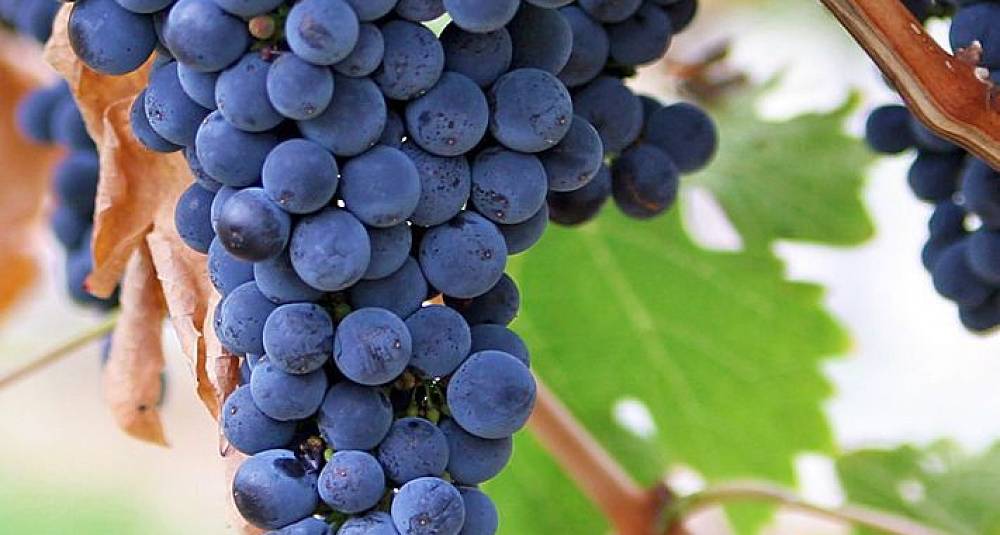


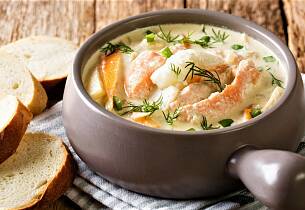
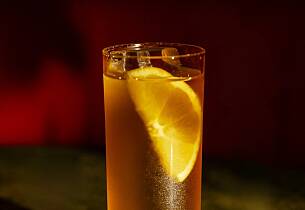


.png)

